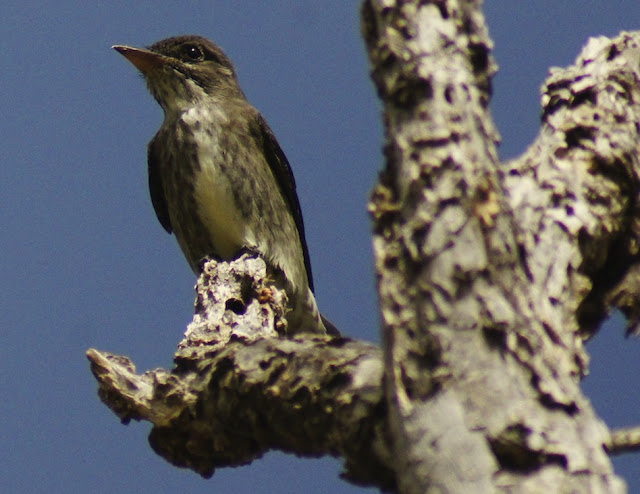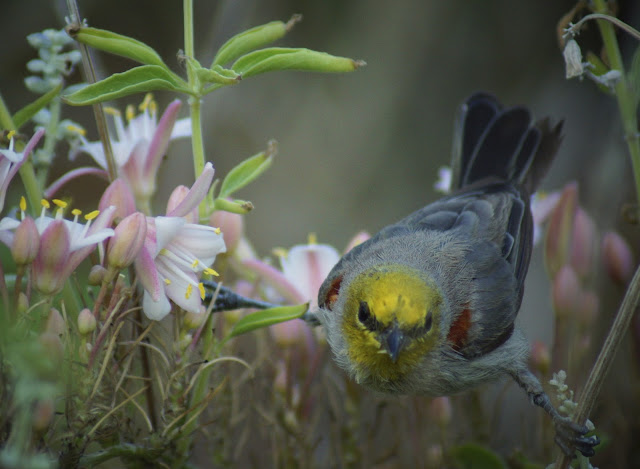There are several genera of birds that are notoriously hard to identify. Here in North America, beginning and experienced bird-watchers alike (ok, mostly beginner) scratch their collective heads over Sparrows, and Gulls, Shorebirds and Flycatchers. Similar plumages and overlapping ranges make it hard to pick apart certain species from some of these groups, and the field guides never seem to quite cover all the bases. For my money, the empid flycatchers are some of the most difficult.
Sure, Gulls are tough, especially in their intermediate/immature plumages. But once they're in their adult molt they're not so tricky, at least not for those with a bit of experience (not that I have much). The same goes for most Shorebirds when they're in their breeding plumage, so at least for part of the year they can be identified without too much headache--although it is a shame so many are up in the Arctic circle during that time. Sparrows are problematic too, and are usually the first difficult group that beginning birders have to tackle. But while their plumages are subtle and similarly colored, the Sparrows can usually be ID'd by plumage alone. This brings me back to the Flycatchers...those look-alike, act-alike flighty little buggers that don't really change their indistinct plumage throughout the year or ever take it easy on a fledgling birder. And so, more for my own review and edification than anything else, here's an inspection of some befuddling Flycatchers I've seen this year.
I first saw this bird in February around Patagonia Lake in southeast AZ and thought it was a Gray Flycatcher. Gray's and Dusky Flycatcher's look very similar, except that Grays have a slightly longer tail and the adults are a bit paler. I think I'll stick to Gray for this bird, but some nagging feeling says this could turn into a Dusky at any moment...or even something much, much more embarrassing.
Also around Patagonia I saw this Hammond's Flycatcher. Going just by general color and demeanor, a Hammond's can turn into a Dusky or Gray Flycatcher too, but luckily they have noticeable longer primary projections on their wings.
With other empids, the wings extend to the base of the tail, but the Hammond's has a longer reach relative to its body. Also, this one posed nicely for me, which makes it my favorite empid right now.
Here in Phoenix, the Pacific-Slope vs. Cordilleran war rages at the Desert Botanical Gardens every summer. Both birds can pass through the area during migration, and they're physically indistinguishable if they keep quiet, which of course they do. How many Gulls or Sparrows or Shorebirds are there that are literally indiscernible from each other unless you hear them call (Probably lots more than I am aware of huh?)?
I have seen these Flycatchers every time I've been to the Desert Botanical Gardens in the summer. Because the Cordillerans typically stay in the higher altitudes, the general opinion among the DBG regulars is that the Flycatchers at the DBG must be Pacific-Slope. However, it's pretty far inland for Pacific Slopes too, so it still doesn't seem any more likely to me that it's one or the other based just on their normal ranges. The Sibley's field guide doesn't show either coming into the Phoenix area much, but the Cordilleran's summer range, though normally at higher altitude, is nearer by. Sibley only shows the Pacific-slopes coming through central Arizona during migration. Empids like the one below can be found at the DBG throughout the whole summer, even on the same perches, which makes me think they're not just migrating through, but are actually sticking around for a few months. Given the options, it seems to me that the likelier bird is the Cordilleran, which at least is a summer resident in nearby parts of the state--even if I must contravene The #1 World Birder's 4th rule about trying to be a better birder.
After so much empid stress, it's nice to find repose with a few easier specimens. So the Olive-sided Flycatcher isn't actually an empid; it's a Pewee. I just included it here because I think they're very cool and really appreciate that they're straightforward to ID. These guys drip class, and you know they like to drink dry martinis, with a couple olives...
The bird photographed below is probably a Willow Flycatcher. I'm ashamed to admit it, but I have a hard time discerning these guys from Western Wood Pewees. The Wood Pewees like to perch up higher, whereas these Willows like the little scrub stuff near marshy water, case in point:
I'm wanted to call this guy an Acadian Flycatcher because it seemed too light all round to be Willow. When I photographed this bird in southeast Pennsylvania, it was within Acadian range. However, the Acadians are supposed to be high tree dwellers like the Pewees, and this fellow was working the low shrubs. Upon further review, I thought this might be an Alder Flycatcher, but honestly its face seems too light to match any of those birds really well. It seems to lack the darker lores of both the Alder and Willow Flycatchers, which brings me back to the lighter-faced Acadian... Suggestions?
Anyway, here's a definite Willow Flycatcher. However, it's not obvious from the photo, since the beak looks too orange and the head looks too crested/peaked--in fact he looks a lot like the ambiguous bird above. But unlike all the other empids I've seen this year, this guy let out a mighty "RITZbew" while I was observing.
Many birders have gone half mad and half insane trying to sort these guys out. It's more crazy-making than trying to contemplate the cardinality of infinite sets that can be greater or smaller than each other despite all being infinite! When the empid finally calls, it is a sweet mercy. Now if only I could recognize their calls...

















































